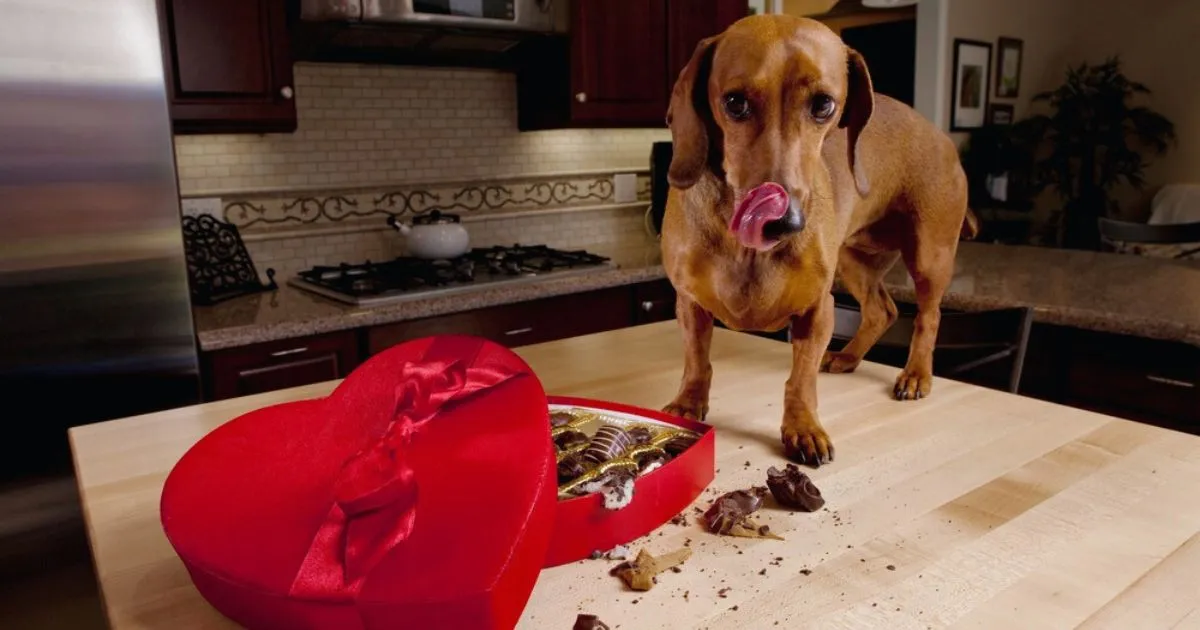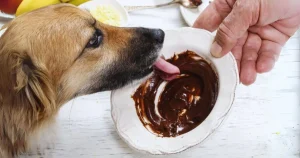10 Symptoms of Dog eating Dark Chocolate

As pet owners, we are always trying to ensure the health and safety of our pets. However, chocolate toxicity in dogs is a severe threat to them. For example, a small amount of dark chocolate can be toxic to dogs, as it includes caffeine and theobromine, which are risky for dogs.
In this article, we’ll discuss why dogs eat dark chocolate and the potential risks that lead to health problems. Here’s everything you need to know about dogs and chocolate, from the toxicity of cocoa to the science behind their cravings.
Understanding Chocolate Toxicity in Dogs
While dark chocolate is a favorite food for humans, it is unsafe for dogs. Theobromine, a natural compound in cocoa beans, primarily causes this danger. Although humans can metabolize theobromine without difficulty, it negatively affects dogs. Milk chocolate has less theobromine than dark chocolate. Dogs can face problems with even small amounts. Several side effects are associated with taking theobromine, including restlessness, vomiting, diarrhea, rapid breathing, increased heart rate, and seizures. The final result can be death. Intakes of theobromine above 100 mg per kilogram are dangerous. Dark chocolate contains about 14 milligrams of theobromine per gram. If your dog ingests dark chocolate, seek immediate veterinary care.
Common Symptoms of Chocolate Toxicity
Peruse the rundown below to familiarise yourself with chocolate-harming canines’ most regular side effects. You must become familiar with these symptoms to identify this issue in your pet before it worsens.
Ten common Symptoms of Dog Eating Chocolate:
Chocolate poisoning in dogs can lead to various symptoms, and it’s crucial to recognize them quickly. Here are some significant signs of your dog overeating chocolate:
1. Vomiting:
For many dogs, this is an early sign that they consumed something unhealthy, like chocolate. It relies on the body’s own defenses to get rid of these harmful substances in any way possible. When a dog does this, it means it needs help right away, maybe from a vet, to stay safe and healthy.
2. Diarrhoea:
Dogs that eat chocolate can get diarrhea and other health issues because it makes their stomachs upset. Additionally, this sign may show up just a few hours after eating it since it features theobromine, a chemical that is bad for dogs. Whatever amount you take in can have affects ranging from minor discomfort to more serious health problems. Canine friends shouldn’t get chocolate. These risks should be known by people who own dogs.
3. Elevated internal heat level:
When a dog’s body temperature is too high, there are signs that show it. Since chocolate has theobromine in it, this is generally a direct reaction to eating chocolate. Because it changes their metabolism in a way that their bodies can’t easily handle, theobromine puts dogs at a higher risk. Some dogs may even die if they eat or drink too much of this. Think about having heart issues, seizures, or even failing and dying. For these potentially dangerous conditions not to happen, dog owners need to be very careful and make sure their dogs don’t eat chocolate.
4. Reflexive action:
Various reactions can grow stronger in dogs after eating chocolate. This is because chocolate contains dangerous chemicals. This raised state can show up as twitching or shaking movements or an evident rise in how sensitive they are to contact, which indicates that it has a big effect on the way they feel. It’s important to know that even small amounts of chocolate can have enough of these toxic substances to hurt a dog’s health. Because of this, pet owners must be careful not to give their dogs chocolate.
5. Muscle spasms:
Chocolate is mostly harmful because it contains theobromine, a chemical that can make people’s and animals’ muscles tighten without them meaning to. Although such contractions are painful, they can also be a sign of a more serious poisoning situation that needs instant attention. In the worst cases, eating a lot of chocolate can harm their health. Heart issues, like arrhythmias or hypertension, and brain issues, like seizures, are some of these. To emphasize how important it is to closely watch how much chocolate people eat, especially pets like dogs and cats, who are more likely to get theobromine poisoning. The risk of harm renders it very important to keep chocolate out of reach of our furry friends and teach pet owners about the dangers of offering chocolate to their pets.
6. Rapid breathing (tachypnea):
Chocolate is poisonous, so it speeds up dogs’ bodies, which shows up as signs like breathing quickly. Chocolate has ingredients like theobromine and caffeine that make these things happen. These poisons aren’t harmful to people, but they’re awful for dogs. Because these chemicals make it hard for dogs to digest their food, they can hurt their bodies and lead to a lot of very bad health problems, such as heart problems, seizures, and even death in the worst cases. People with barking dogs need to know about these risks and assure they can’t get to chocolate.
7. Elevated pulse (tachycardia):
People enjoy chocolate and it’s good for them in many ways, but our pets shouldn’t eat it. These sweet treats have a chemical called theobromine in them that is bad for dogs but not for people. It’s terrible for dogs’ muscles and nerves if they eat theobromine. The heart rate might go up too quickly because of this. Getting shakes, passing out, or even heart problems in the worst cases is possible if your heart rate goes up. For the sake of their health and to avoid accidents, pet owners should always keep chocolate out of reach of their animals.
8. High or low blood pressure:
Variations in the condition can be big depending on how much chocolate the dog ate and how its body responded. To be more specific, the dog’s blood pressure may either go up or down a lot. In both cases, there are big health risks. Strokes and other conditions involving high blood pressure can be deadly, while a big drop in blood pressure can cause shock or even death.
9. Seizures:
Chocolate has a lot of chemicals that are bad for dogs. Teaspoon and coffee are two of them. They could hurt or kill them. Dogs can face these poisons, die, or have very bad nerve symptoms like shaking and seizures. Because they can’t handle them as well as people can, dogs shouldn’t be near these chemicals. The least amount of chocolate should be avoided. Any dog that eats chocolate and then acts up should be taken to the vet right away. Quickly visiting a doctor will help your dog’s health stay better and stop it from getting worse.
10 High-Level Symptoms: If undetected, chocolate becomes toxic in the following ways:
- Unconsciousness: The dog becomes slow and sluggish.
- Cardiovascular Arrhythmias: Unexpected pulses endanger their prosperity.
- Heart failure: a fatal complication. Note that primary mediation is fundamental to a higher estimate.
If you suspect your pet may have ingested chocolate, immediately contact the Pet Poison Helpline at 855-764-7661, your veterinarian, or an emergency vet.
How much Chocolate is Poisonous to Dogs?

Several types of chocolate toxicity cause adverse reactions in dogs, including the type of chocolate consumed, the size of the dog, and its metabolism. Both caffeine and theobromine, found in chocolate, are the culprits. Here’s a breakdown.
- Dark chocolate: Its high theobromine content makes even small amounts dangerous.
- Milk Chocolate: As little as 1 ounce per pound of body weight can be fatal for dogs.
- Cocoa powder: Just a few teaspoons can cause severe symptoms.
We have to be very careful with the toxicity of chocolate as there are health risks for pets. In exceptional cases, it may be necessary to consult with a veterinarian.
Which types of Chocolate are Bad for Dogs?
Caffeine and theobromine belong to the methylxanthine class of chemicals and are bad for our dogs. Dogs metabolize these ingredients more slowly than humans, making chocolate consumption potentially harmful. Even small amounts of chocolate cause symptoms such as vomiting, diarrhea, rapid breathing, high heart rate, seizures, and in severe cases, death.
Here is a list of different types of chocolate, from highest to lowest, in terms of methylxanthine content (measured in milligrams per ounce):
- Cocoa powder: about 800 mg/oz (28.5 mg/g)2.
- Baking chocolate (without sweet): About 450 mg/oz (16 mg/g)2.
- Various dark chocolates: about 150-160 mg/oz (5.4-5.7 mg/g)2.
- Milk chocolate: Contains about 64 mg/oz (2.3 mg/g)2.
- Cocoa bean hulls about 255 mg/oz (9.1 mg/g)2.
Just keep in mind that bitter and dark chocolate is more harmful to dogs. In other words, a 50-pound dog is just as likely to get sick from eating 8 ounces (12 pounds) of milk chocolate as eating 1 ounce of baker’s chocolate.
Please seek veterinary care immediately if you notice signs that your dog has ingested chocolate. Early treatment always leads to a better outcome. But white chocolate doesn’t contain the harmful methylxanthines in real chocolate so it won’t harm your dog.
What to Do if Your Dog Eats Chocolate Accidentally?

If your dog has eaten chocolate, taking immediate action is essential because of the highly toxic chemical theobromine. Assess the situation by determining the type and amount of chocolate, ranging from baker’s to milk chocolate. Consult your vet, who may prescribe anti-emetics if eaten within the last hour. If your regular vet is closed, contact an emergency vet. If the chocolate was consumed within the last hour and there are no neurological symptoms, administer hydrogen peroxide (3%) to induce vomiting. Follow your vet’s guidelines for professional advice.
How to Prevent Dogs from Eating Too Much Chocolate
Chocolate toxicity in dogs can be a severe health problem, depending on the type and amount consumed. Here are some things you can do to prevent your furry friend from eating this dangerous treat:
- Keeping chocolate out of reach: Dogs are curious creatures whose noses can lead them to sweet treats. Store chocolate products in a high cabinet or container your dog can’t reach. Be extra careful around the holidays when chocolate is in abundance.
- Know the Differences in Chocolate: Different chocolates contain different amounts of theobromine, a toxic substance for seizures. Cocoa powder is the most harmful, followed by unsweetened chocolate, semi-sweet chocolate, and dark latte. Milk chocolate has a low bromine content, but some can be harmful, especially for small dogs.
- Calculate: Use a chocolate toxicity calculator to assess your dog’s risk based on weight and chocolate intake. Generally, dogs experience mild symptoms when consuming 20 mg of methylxanthines (such as theobromine and caffeine) per kg of body weight. Cardiac symptoms occur at about 40 to 50 mg/kg, and seizures are standard at 60 mg/kg.
- Recognize your potential for poisoning: If the attack is chocolate, watch for signs of poisoning, which typically appear within 6 to 12 hours. These can last up to 72 hours and include vomiting, diarrhea, restlessness, increased urination, a high heart rate, and seizures. Older adults have a higher risk of stroke and heart disease.
- Get help immediately: If you suspect your dog has eaten chocolate, call your veterinarian or the Pet Poison Helpline (855-213-6680) for advice. Quick action can significantly improve your dog’s results.
- Offer safe alternatives: Instead of chocolate, offer your pet dog-safe treats like carob. Carob is a tasty alternative that won’t harm your furry friend.
Prevention is key to keeping your dog safe from chocolate emergencies.
Effective Treatment of Chocolate Poisoning in Dogs
If you notice that your dog has ingested chocolate, immediate action is necessary. Follow these steps to prevent chocolate toxicity:
1. Assess the Situation:
It is critical to ascertain the type and quantity of chocolate consumed. The chemical theobromine is known to be bad for dogs. Various types of chocolate contain various amounts of this chemical. There is a lot of theobromine in dark chocolate and baking chocolate. This means that even small amounts of these sweets are bad for a dog’s health. How possible and bad is it for a dog to overdose on theobromine? You need to know what kind of chocolate they ate and how much they ate.
2. Contact Your Veterinarian:
Immediately take action if you notice your dog consumed chocolate. Examine the issue carefully to figure out how serious it is. Get help immediately by calling your vet or an animal poison hotline. If you know, explain to them exactly when your dog ate the chocolate and what kind it was. They will understand how to evaluate the risks and tell you exactly what to do next to keep your pet healthy and safe. Activated charcoal, making your dog sick, or bringing them in for a check-up may all trigger this.
3. Induce vomiting (if advised):
Your vet will advise you on the safest way to make your dog throw up after eating chocolate if they suggest you do so. This approach is usually only prescribed if the intake was very recent, like within the last two hours. You can stop your dog from absorbing more of the chocolate’s toxic elements into his bloodstream the most effectively during this time frame.
4. Observe for Symptoms:
Look out for signs of chocolate poisoning, which may include vomiting, diarrhea, anxiety, increased urination, tremors, an elevated heart rate, and seizures. Older dogs and those with heart conditions are more vulnerable.
Consult a professional:
- Seek immediate veterinary attention if symptoms occur.
- A veterinarian may administer activated charcoal to absorb any remaining theobromine.
- In severe cases, hospitalization and supportive care (IV fluids, medications) may be needed.
Monitor Your Dog:
- Keep your dog calm and relaxed.
- Observe any changes in behavior or symptoms.
- Follow your vet’s advice regarding monitoring and treatment.
Keep in mind prevention is the most effective approach. Keep chocolate out of reach, educate family members about its dangers, and opt for dog-safe treats instead.
FAQs:
Q1: What type of chocolate can I give my dog?
No, it would help if you did not give your dog chocolate. It contains substances that are toxic to dogs, such as theobromine and caffeine. Even little amounts might cause serious health problems. If your dog consumes chocolate, take them to the vet immediately.
Q2: Can dogs be toxic to chocolate for a long time?
When a dog consumes chocolate, the signs of chocolate toxicity can occur within 1 to 4 hours. Theobromine and caffeine compounds influence these symptoms like vomiting, diarrhea, and muscle rigidity. They can vary depending on the type and amount consumed.
Q3: Can dogs eat milk chocolate?
Milk chocolate can be toxic to dogs. While it’s less dangerous than dark chocolate, it contains theobromine, which dogs metabolize slowly. For a 10-pound dog, around 3.5 ounces of milk chocolate can be difficult. Seek quick veterinary care if your dog eats chocolate.
Q4: How do I stop if my dog eats dark chocolate?
Contact your vet or an animal poison control center right away if you think your dog has eaten dark chocolate. Dogs should not eat dark chocolate because it contains a lot of theobromine. Based on its size and how much chocolate it eats, these professionals can tell you about your dog’s health.
Read More Article: 10 Homemade Dog Food Recipes for Dogs with Allergies.

